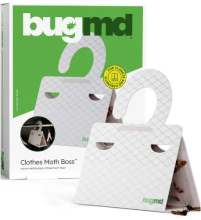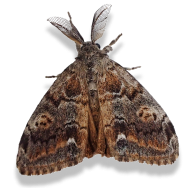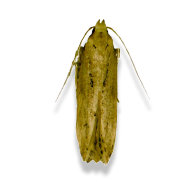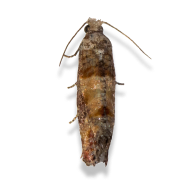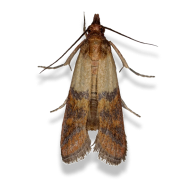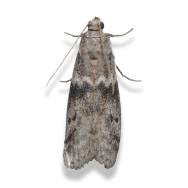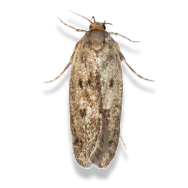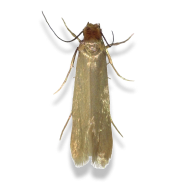The silent destroyers in your closet: understanding clothes moths
While many moths flutter harmlessly around your porch light, their cousins, the clothes moths are, you guessed it, moths that eat clothes, and they are silently wreaking havoc in your closets, wardrobes, or anywhere you store garments.
Have you ever pulled out your favorite vintage sweater only to discover mysterious holes? Or found your grandmother's wool coat so damaged it looked like just strips of fabric? Then you've already met these notorious clothing destroyers.
Clothes moths belong to a specialized family of pests that have evolved over time to eat our most precious garments. Unlike their outdoor relatives, these moths prefer the dark, undisturbed corners of our closets, where they can remain unseen for months while causing extensive damage.
What makes these moths particularly annoying is their reproduction cycle. A single female moth can lay up to 50 eggs, often tucked away in the folds of your clothing.1 When these eggs hatch, the larvae immediately begin feeding on natural fibers like wool, silk, cashmere, and fur, which are the materials found in our favorite garments.
The most common clothes moth species, the Webbing Moth, moves with a distinctive flutter, often keeping close to stored fabrics rather than flying toward lights. Their partners in crime, Casemaking Moths, display similar behavior but are slightly harder to spot due to the fact they prefer darker corners.
Finding these moths early and preventing them are key in keeping them out!
Early detection and prevention are key for both types of moths!
How to identify clothes moths
Understanding the signs of clothes moths can mean the difference between saving your wardrobe and facing all kinds of losses.
You might be surprised to learn that those small, golden-colored moths darting across your closet aren't just harmless visitors, they're the sign of an active invasion. Adult clothes moths are small, measuring only about 1/4 inch long, with distinctive golden wings that shimmer in the light.2 But here's what most people don't realize: if you're seeing adult moths, the real damage has already started.
The most common clothes moth species, the Webbing Moth, moves with a distinctive flutter, often keeping close to stored fabrics rather than flying toward lights. Their partners in crime, Casemaking Moths, display similar behavior but are slightly harder to spot due to the fact they prefer darker corners.
- Silken tubes or webbing - Finding small, sticky silk cases or tunnels attached to fabric, which are created by moth larvae as they feed and move across your clothes.
- Random holes in fabrics - Small, random holes appearing in wool, silk, or other natural fiber clothing, especially in dark areas that go undisturbed for longer periods of time like closets.
- Small silvery-white moths - Adult clothes moths fluttering around closets or drawers, particularly active in dim lighting and usually flying in an irregular pattern.
The impact on your home and belongings
Moths in houses don't sound that bad however these moths quickly escalate into an expensive nightmare. Unlike common house moths that are just annoying, clothes moths are made to destroy your possessions. While they don't pose any direct health risks to humans, the financial and emotional toll can be very overwhelming.
A single moth invasion can destroy thousands of dollars worth of clothing in a matter of months. That designer wool coat you invested in? A cashmere sweater collection passed down through generations? Your child's first hand-knit baby blanket? What about your wedding dress you’ve had saved for years? All can turn into just holes before you even notice. Once damaged, these precious items can never truly be made to look like they did before.
Why alternative solutions might not work
A single moth invasion can destroy thousands of dollars worth of clothing in a matter of months. That designer wool coat you invested in? A cashmere sweater collection passed down through generations? Your child's first hand-knit baby blanket? What about your wedding dress you’ve had saved for years? All can turn into just holes before you even notice. Once damaged, these precious items can never truly be made to look like they did before.
How to get rid of moths in closet
If you spot clothes moths in your home, taking quick action is essential to protect your valuable garments.
Here's what you need to do:
- Remove all clothing from the invaded area and inspect each item carefully
- Wash or dry clean all clothing immediately and items that can't be washed should be put in sealed plastic bags separate from everything else
- Remember to clean the storage area thoroughly before returning any items.
- For effective, long-lasting protection against clothes moths use moth traps like Clothes Moth Boss.
After treatment, store clothing that you only use every now and then in airtight containers and regularly inspect your closet for signs of any moth activity. Keep your closet clean and open, as moths prefer dark spaces that you don’t visit often.
Treat moths with Clothes Moth Boss
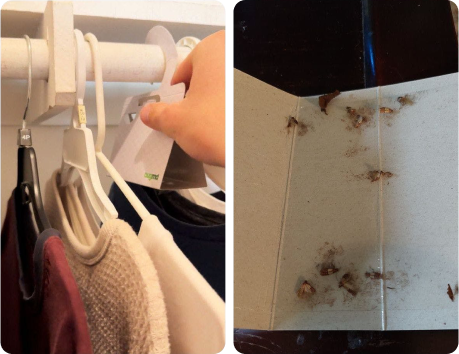
If you're tired of finding holes in your favorite clothes, the best solution is a pheromone-powered, targeted treatment like Clothes Moth Boss.
Clothes Moth Boss is a specialized moth control solution designed specifically to lure male moths using pheromones right into the ultra-sticky, trapping and eliminating them with ease. This disrupts the breeding cycle and protects your variables.



FAQs
No, adult clothes moths do not have mouths large enough to physically bite humans. In fact, adult clothes moths don't feed at all, it's their larvae that cause damage to clothing and fabrics.
While moths in general are important pollinators and food sources for birds and bats, clothes moths are considered pests when they invade homes. Unlike their outdoor relatives, clothes moths serve no beneficial purpose in your closet or wardrobe.
Yes, clothes moths damage clothing through their larvae. Adult moths lay eggs on natural fibers like wool, silk, fur, and feathers. When the eggs hatch, the larvae feed on these materials, causing holes and damage to your garments.
Adult clothes moths typically live for 2-3 weeks, with their primary purpose being reproduction. However, the larvae stage, where all the damage occurs, can last several months depending on conditions. In ideal environments, the entire life cycle from egg to adult can take 4-6 months.

Clothes Moth Boss
